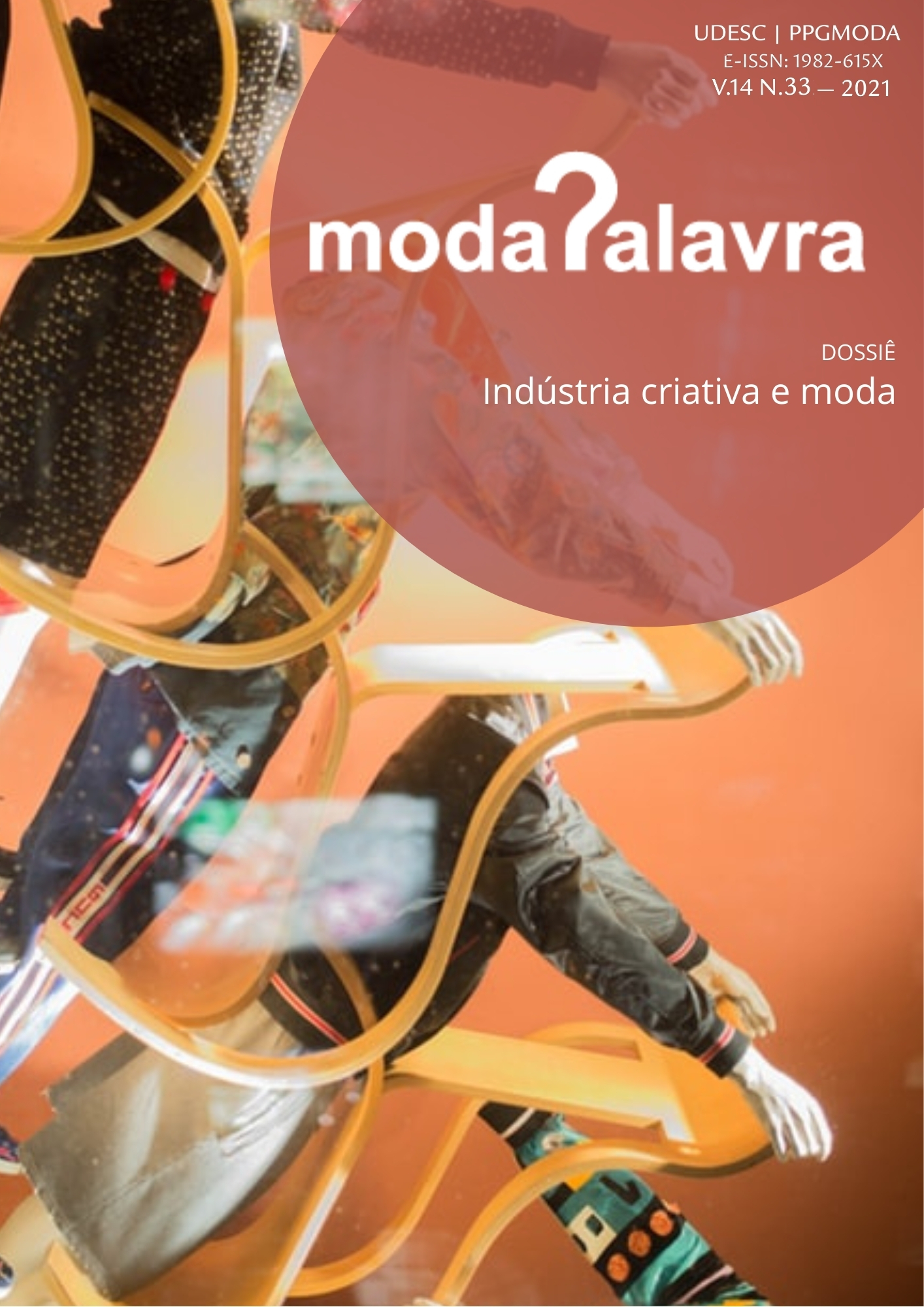Innovation, conformity and other ambivalences in fashion design
DOI:
https://doi.org/10.5965/1982615x14332021014Keywords:
fashion design, creation, innovationAbstract
This article problematizes the creation in fashion design. A noticeable majority of companies in the fashion market accompanies trends, which are edited by bureaux de style, disseminated by fashion designers at week runway shows and advertised as successful bets by the fashion media. This investigation results from the development of a research about the agency of fashion designers. The given scope emphasizes the dialectics of creation x adequacy and innovation x security. More specifically, the paper addresses the considerations of three interviewees conducted for the validation of the research’s results. During the dialogues - which consisted of informal telephone conversations aided by a semi-structured script – the professionals reported their reflections on deliberate acts of creation and the business logic of fashion design corporations.
Downloads
References
BAKEWELL, Cathy; MITCHELL, Vincent-Wayne. Male versus female consumer decision making styles. Journal Of Business Research, [s.l.], v. 59, n. 12, p. 1297-1300, nov. 2006. Disponível em: http://dx.doi.org/10.1016/j.jbusres.2006.09.008. Acesso em: 7 mar. 2023.
BIOUSSE, Frédéric. Quel avenir pour les tendances? p.70-79. In: BACRIE, Lydia. (ed.). Qu’est-ce qu’une tendance de mode?. Paris: Fédération Française du Prêt à Porter Féminin, 2012.
CAMPOS, Amanda Queiroz. O mito como incremento do produto na gestão da marca de moda: estudo de imagens gráfico publicitárias das marcas Lança Perfume e Morena Rosa. Dissertação de Mestrado. Programa de Pós-Graduação em Design e Expressão Gráfica. Universidade Federal de Santa Catarina. Florianópolis: 2013.
CAMPOS, Amanda Queiroz. Of tradition and creation: the discourse of fashion designers on trend report use. Tese de Doutorado em cotutela. Programa de Pós-Graduação em Design e Expressão Gráfica. Universidade Federal de Santa Catarina & Doktorprogram in Kunst und Design der Bergischen Universität Wuppertal. Florianópolis/Wuppertal: 2017.
ČIARNIENė, Ramunė; VIENAžINDIENė, Milita. Management of Contemporary Fashion Industry: characteristics and challenges. Procedia - Social And Behavioral Sciences, [s.l.], v. 156, p. 63-68, nov. 2014. Disponível em: 10.1016/j.sbspro.2014.11.120. Acesso em: 7 mar. 2023.
DHURUP, Manilall. Impulsive Fashion Apparel Consumption: the role of hedonism, fashion involvement and emotional gratification in fashion apparel impulsive buying behaviour in a developing country. Mediterranean Journal of Social Sciences, [s.l.], p. 168-177, 1 maio 2014. Disponível em: 10.5901/mjss.2014.v5n8p168. Acesso em: 7 mar. 2023.
GODART, Fredèric. Sociologia da moda. [Sociologie de la mode]. São Paulo, SP: SENAC SP, 2010.
EDELKOORT, Li. Anti-Fashion: A Manifesto for the Next Decade | #BoFVOICES. Disponível em: https://www.youtube.com/watch?v=LV3djdXfimI. Acesso em: 14 mar. 2018.
HANSEN-HANSEN, Erik. Learning from (luxury) fashion: entrepreneurship and design-led innovation. Proceedings of Innovation Through Design, 2012 International Design Management Research Conference; DMI: Boston, August 8- 9, 2012.
HUNG, Wei-Ken; CHEN, Lin-Lin. Effects of Novelty and Its Dimensions on Aesthetic Preference in Product Design. International Journal of Design. v.6, n.2. p. 81-90, 2012. Disponível em: http://www.ijdesign.org/index.php/IJDesign/article/view/1146. Acesso em: 7 mar. 2023.
JONES, Susan Jenkin. Fashion design. 3. ed. London: Laurence King Publishing, 2011.
KAWAMURA, Yuniya. Fashion-ology: an introduction to fashion studies. 1. reimp. London;New York: Bloomsburry, 2014.
MOZOTA, Brigitte Borja de. Gestão do Design: usando o design para construir valor de marca e inovação corporativa. [Design management]. Porto Alegre: Bookman, 2011.
OECD. Oslo Manual: guidelines for collecting and interpreting innovation data. 2005. Disponível em: https://www.oecd.org/sti/inno/2367580.pdf. Acesso em: 10 abr. 2016.
SAVIOLO, Stefania; TESTA, Salvo. La gestión de las empresas de moda. [Strategic Management in the Fashion Companies]. 1. ed. 10. reimp. Barcelona: Gustavo Gili, 2015.
SCHÜßLER, Elke. Strategische Prozesse und Persistenzen: Pfadabhängige Organisation der Wertschöpfung in der Bekleidungsindustrie. Tese de doutorado. Freie Universität Berlin, 2008.
SKOV, Lise; MELCHIOR, Marie Riegels. Research approaches to the study of dress and fashion. In: EICHER, J.O. Berg Encyclopedia of World Dress and Fashion, p.1-18. Oxford: Berg, 2010.
SVENDSEN, Lars. Filosofia da moda. [Fashion: A Philosophy]. Rio de Janeiro, RJ: Zahar, 2011.
VERGANTI, Roberto. Design-driven innovation: mudando as regras da competição: a inovação radical do significado de produtos. [Design-Driven Innovation: Changing the Rules of Competition by Radically Innovating What Things Mean]. São Paulo: Canal Certo, 2011.
Downloads
Published
How to Cite
Issue
Section
License
Copyright (c) 2021 Amanda Queiroz Campos

This work is licensed under a Creative Commons Attribution-NonCommercial 4.0 International License.
When submitting an article for publication in ModaPalavra e-periodico, the author (s) agree (s) with the following terms:
- Authors maintain the copyright in their manuscripts and grant the journal the right of first publication, with work simultaneously licensed under the Creative Commons Attribution-NonCommercial 4.0 International, which allows sharing the work with the acknowledgment of authorship and the initial publication in the journal without payment ;
- Authors may use the same results in other publications after the first publication, provided that they indicate ModaPalavra e-journal as the original publication medium;
- Authors are authorized to take additional contracts, separately, only after the original publication in ModaPalavra e-journal, provided they indicate ModaPalavra e-journal as the original publication medium;
- Authors are allowed and encouraged to publish and distribute their work online (eg in institutional repositories or on their personal page), only after the editorial process and the first publication, provided they indicate ModaPalavra e-journal as the original publication medium;
- To indicate ModaPalavra e-journal as the original publication medium, authors should use the following text template: "This article was originally published by ModaPalavra e-periodical, under a CC BY NC license, in its volume [insert volume] number [insert number] in the year of [insert year], and can be accessed at: http://www.revistas.udesc.br/index.php/modapalavra/ ";
- The opinions expressed in the articles are the author’s sole responsibility, not necessarily reflecting the journal’s opinion. The publication of any material that is owned and held in copyright by a third party, including – but not limited to - articles, photos or drawings was previously authorized by their representatives to be published in ModaPalavra e-journal.









